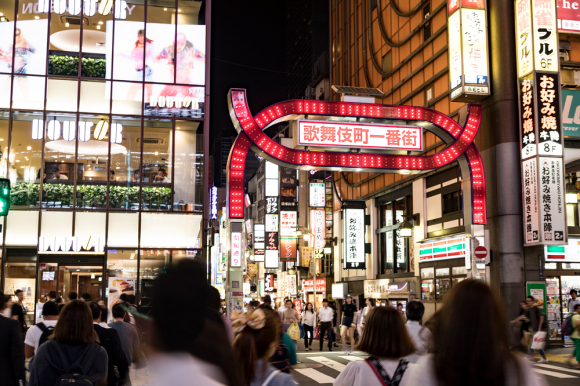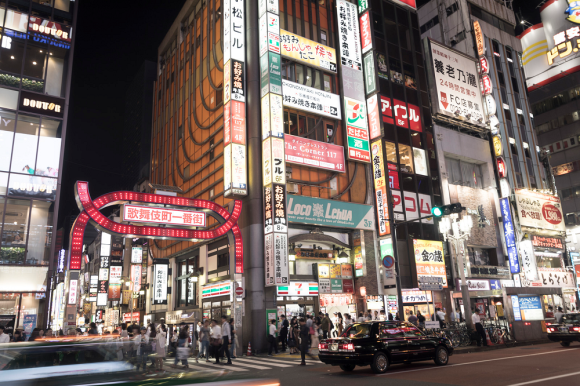
The lure of cheap booze is hard to resist, but before you follow that discount-promising tout, take a moment to check what clothes he’s wearing.
In many ways, Japan is a drinker’s paradise. Japanese society is extremely accepting of alcohol consumption, to the point where you can enjoy adult beverages not just at bars and cafes, but even many fast food restaurants. Then there are the all-you-can-drink deals, some of which are amazingly cheap.
There is one very big possible downside to knocking back a few cold ones in Japan, though. As we’ve talked about before, in entertainment districts you’ll often find kyakuhiki (“customer-pullers”) working the streets, trying to steer customers into the bars or izakaya (Japanese-style pubs) that employ them. While pushy, many of these kyakuhiki are on the up-and-up and work for respectable restaurants. Some of them, though, are out to pull you into shady establishments that will slap hidden fees and service charges onto your tab, leaving you with an astronomical bill for a couple of drinks and snacks.
To help spot these scam artists, Japanese Twitter user @arinotsuno has created a list of things to be on the lookout for.
https://twitter.com/arinotsuno/status/882314234519891968The typical modus operandi of the unsavory kyakuhiki is to attract suckers with promises of discounts at a reputable chain, then somehow divert them to his bosses’ place to get ripped off instead. To protect yourself from this bait-and-switch, the first thing @arinotsuno says you should be on the lookout for is how the kyakuhiki is dressed. Japanese businesses love uniforms, so if a kyakuhiki dressed in street clothes claims to be a representative of a major chain, he’s a fake.
As for how the scam goes down, @arinotsuno says there are two primary points of attack. In one of the, kyakuhiki approaching people who’re simply walking down the street, cordially asking if you’re looking for an izakaya and promising discounts for one popular chain or another. If you show an interest, he’ll enthusiastically offer to check to see if there’s a table available, whipping out a cell phone or tablet ostensibly for that purpose.
Really, @arinotsuno says, these electronic devices are just props the kyakuhiki is using to help sell his act. He’s not really contacting the restaurant he said he would, and after a few seconds he’ll regretfully tell you ”Sorry, the restaurant is full. But there’s another place with different owners that I can get you into right away.” Getting you into this other restaurant, of course, was his intention from the start.
Alternatively, some scam artist kyakuhiki wait to strike until you’re about to enter one of the multi-floor buildings packed with various bars and restaurants that are commonly found in Japanese cities. As you’re about to go into the lobby area or hop on the elevator, the kyakuhiki will appear, saying “Oh, are you going to eat here? I’m in charge of the restaurants in this building.” Right off the bat, this is fishy, since the restaurants in the building are competitors, and thus don’t share kyakuhiki employees.
When you tell him which specific restaurant you’re headed for, he’ll put on a show of feigned thoughtfulness, telling you “Actually, that whole restaurant is rented out for a group function tonight. Oh, but I can get you a seat at a restaurant with different ownership…”
So in summary, the biggest warning flags to look for are guys in regular clothes claiming to be working for a chain, kyakuhiki and, more critically, kyakuhiki whose story has them working for multiple restaurants with different owners. Give them both wide berth, and you’ll be a lot closer to a hangover being your biggest potential regret after a night out in Japan.
Source: Twitter/@arinotsuno via Jin
Top image: Pakutaso
Insert images: Pakutaso


 Heroic Japanese convenience store owner saves foreigner from online scam artist
Heroic Japanese convenience store owner saves foreigner from online scam artist How a bar in Kabukicho scammed one diner out of their money, and how it can happen to you too
How a bar in Kabukicho scammed one diner out of their money, and how it can happen to you too Enjoy a free beer in Tokyo every single day with awesome monthly mobile app
Enjoy a free beer in Tokyo every single day with awesome monthly mobile app Is it a crime to ditch a bad date and leave them with the bill? Japanese man finds out
Is it a crime to ditch a bad date and leave them with the bill? Japanese man finds out Japan’s top 10 best-value family restaurants, as chosen by diners
Japan’s top 10 best-value family restaurants, as chosen by diners McDonald’s new Happy Meals offer up cute and practical Sanrio lifestyle goods
McDonald’s new Happy Meals offer up cute and practical Sanrio lifestyle goods More foreign tourists than ever before in history visited Japan last month
More foreign tourists than ever before in history visited Japan last month Starbucks reopens at Shibuya Scramble Crossing with new look and design concept
Starbucks reopens at Shibuya Scramble Crossing with new look and design concept Arrest proves a common Japanese saying about apologies and police
Arrest proves a common Japanese saying about apologies and police Is the new Shinkansen Train Desk ticket worth it?
Is the new Shinkansen Train Desk ticket worth it? The oldest tunnel in Japan is believed to be haunted, and strange things happen when we go there
The oldest tunnel in Japan is believed to be haunted, and strange things happen when we go there Tokyo’s most famous arcade announces price increase, fans don’t seem to mind at all
Tokyo’s most famous arcade announces price increase, fans don’t seem to mind at all Randomly running into a great sushi lunch like this is one of the best things about eating in Tokyo
Randomly running into a great sushi lunch like this is one of the best things about eating in Tokyo Our reporter takes her 71-year-old mother to a visual kei concert for the first time
Our reporter takes her 71-year-old mother to a visual kei concert for the first time We try out “Chan Ramen”, an underground type of ramen popular in the ramen community
We try out “Chan Ramen”, an underground type of ramen popular in the ramen community Disney princesses get official manga makeovers for Manga Princess Cafe opening in Tokyo
Disney princesses get official manga makeovers for Manga Princess Cafe opening in Tokyo Foreign English teachers in Japan pick their favorite Japanese-language phrases【Survey】
Foreign English teachers in Japan pick their favorite Japanese-language phrases【Survey】 Beautiful new Final Fantasy T-shirt collection on the way from Uniqlo【Photos】
Beautiful new Final Fantasy T-shirt collection on the way from Uniqlo【Photos】 There’s a park inside Japan where you can also see Japan inside the park
There’s a park inside Japan where you can also see Japan inside the park New Studio Ghibli bedding sets are cool in all senses of the word
New Studio Ghibli bedding sets are cool in all senses of the word Japanese convenience store packs a whole bento into an onigiri rice ball
Japanese convenience store packs a whole bento into an onigiri rice ball Hanton rice — a delicious regional food even most Japanese people don’t know about, but more should
Hanton rice — a delicious regional food even most Japanese people don’t know about, but more should New Pokémon cakes let you eat your way through Pikachu and all the Eevee evolutions
New Pokémon cakes let you eat your way through Pikachu and all the Eevee evolutions Hamburg and Hamburg Shibuya: A Japanese restaurant you need to put on your Tokyo itinerary
Hamburg and Hamburg Shibuya: A Japanese restaurant you need to put on your Tokyo itinerary Studio Ghibli releases Kiki’s Delivery Service chocolate cake pouches in Japan
Studio Ghibli releases Kiki’s Delivery Service chocolate cake pouches in Japan Japan’s bone-breaking and record-breaking roller coaster is permanently shutting down
Japan’s bone-breaking and record-breaking roller coaster is permanently shutting down New definition of “Japanese whiskey” goes into effect to prevent fakes from fooling overseas buyers
New definition of “Japanese whiskey” goes into effect to prevent fakes from fooling overseas buyers Foreign passenger shoves conductor on one of the last full runs for Japan’s Thunderbird train
Foreign passenger shoves conductor on one of the last full runs for Japan’s Thunderbird train Our Japanese reporter visits Costco in the U.S., finds super American and very Japanese things
Our Japanese reporter visits Costco in the U.S., finds super American and very Japanese things Kyoto bans tourists from geisha alleys in Gion, with fines for those who don’t follow rules
Kyoto bans tourists from geisha alleys in Gion, with fines for those who don’t follow rules Studio Ghibli unveils Mother’s Day gift set that captures the love in My Neighbour Totoro
Studio Ghibli unveils Mother’s Day gift set that captures the love in My Neighbour Totoro Domino’s Japan now sells…pizza ears?
Domino’s Japan now sells…pizza ears? New Japanese KitKat flavour stars Sanrio characters, including Hello Kitty
New Japanese KitKat flavour stars Sanrio characters, including Hello Kitty Kyoto creates new for-tourist buses to address overtourism with higher prices, faster rides
Kyoto creates new for-tourist buses to address overtourism with higher prices, faster rides Sales of Japan’s most convenient train ticket/shopping payment cards suspended indefinitely
Sales of Japan’s most convenient train ticket/shopping payment cards suspended indefinitely Sold-out Studio Ghibli desktop humidifiers are back so Totoro can help you through the dry season
Sold-out Studio Ghibli desktop humidifiers are back so Totoro can help you through the dry season Japanese government to make first change to romanization spelling rules since the 1950s
Japanese government to make first change to romanization spelling rules since the 1950s Ghibli founders Toshio Suzuki and Hayao Miyazaki contribute to Japanese whisky Totoro label design
Ghibli founders Toshio Suzuki and Hayao Miyazaki contribute to Japanese whisky Totoro label design Doraemon found buried at sea as scene from 1993 anime becomes real life【Photos】
Doraemon found buried at sea as scene from 1993 anime becomes real life【Photos】 Tokyo’s most famous Starbucks is closed
Tokyo’s most famous Starbucks is closed One Piece characters’ nationalities revealed, but fans have mixed opinions
One Piece characters’ nationalities revealed, but fans have mixed opinions We asked a Uniqlo employee what four things we should buy and their suggestions didn’t disappoint
We asked a Uniqlo employee what four things we should buy and their suggestions didn’t disappoint Princesses, fruits, and blacksmiths: Study reveals the 30 most unusual family names in Japan
Princesses, fruits, and blacksmiths: Study reveals the 30 most unusual family names in Japan Studio Ghibli’s new desktop Howl’s Moving Castle will take your stationery on an adventure
Studio Ghibli’s new desktop Howl’s Moving Castle will take your stationery on an adventure Japan super budget dining – What’s the best way to spend 1,000 yen at sushi restaurant Sushiro?
Japan super budget dining – What’s the best way to spend 1,000 yen at sushi restaurant Sushiro? We visit super popular tuna specialty joint Izakaya Hitoshi on Okinawa’s Ishigaki Island
We visit super popular tuna specialty joint Izakaya Hitoshi on Okinawa’s Ishigaki Island Cheapo News: We find a place in Hiroshima serving tonkatsu pork cutlets for just 350 yen
Cheapo News: We find a place in Hiroshima serving tonkatsu pork cutlets for just 350 yen Pre-pubescent boy in Japan uses his high voice to impersonate a schoolgirl in prostitution scam
Pre-pubescent boy in Japan uses his high voice to impersonate a schoolgirl in prostitution scam Golden Japanese toilet appears at “multi-millionaire” izakaya in Tokyo
Golden Japanese toilet appears at “multi-millionaire” izakaya in Tokyo All-you-can-eat meat offered by restaurant in the heart of Tokyo for less than 10 bucks
All-you-can-eat meat offered by restaurant in the heart of Tokyo for less than 10 bucks Japanese supermarket entrusts customers with unusual discount sticker system
Japanese supermarket entrusts customers with unusual discount sticker system Chinese restaurant gives discounts to women based on their breast size, G-cup gets 65 percent off
Chinese restaurant gives discounts to women based on their breast size, G-cup gets 65 percent off We buy a sushi-restaurant-themed bath bomb that threatens to smell like the ocean
We buy a sushi-restaurant-themed bath bomb that threatens to smell like the ocean Pervert hunter arrested by Tokyo police for less-than-pure intentions
Pervert hunter arrested by Tokyo police for less-than-pure intentions Japanese police question man for “not looking good in a suit,” turns out he robbed an old lady
Japanese police question man for “not looking good in a suit,” turns out he robbed an old lady Japanese curry chain is highly recommended by foreigners on Reddit, but is it any good?
Japanese curry chain is highly recommended by foreigners on Reddit, but is it any good? Our Japanese writers were taken to a mystery destination for their year-end party
Our Japanese writers were taken to a mystery destination for their year-end party King of Japan’s bar hosts shares idea for a sure-fire romantic date
King of Japan’s bar hosts shares idea for a sure-fire romantic date Eat for free at this restaurant in China…but only if you’re beautiful enough!
Eat for free at this restaurant in China…but only if you’re beautiful enough!
Leave a Reply